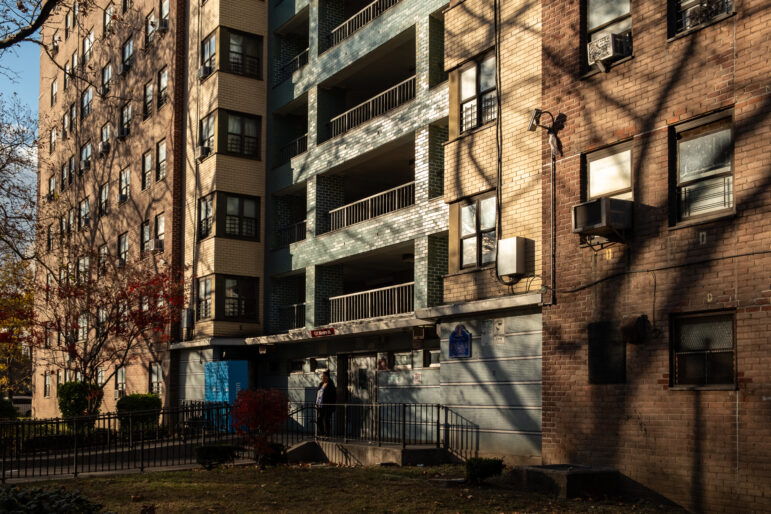When Thelma Utsey took over her East New York townhouse in 1988, the bottom floor was a garbage pit, littered with trash, old clothes and couches. It took family and friends a week and a half to clear it all out before she could even begin assessing what needed to be fixed.
Utsey had just been evicted from her old house a few blocks away and was desperate for a place to live. She had been rejected for public housing and couldn’t afford the rents private landlords were charging. So, taking a cue from her parents, who had homesteaded in a similar house a block away during the early 1970s, Utsey decided to squat at 527 Linwood Street.
Then the real work began: During the next decade she plowed about $25,000 into her new home, replacing the plumbing, the floors, a staircase, the boiler and many of the walls. With advice from her do-it-yourself parents and help from friends, Utsey and her family converted the ramshackle two-story frame building into a homey single-family residence. Along the way, she endured a few scrapes–like the time she and a group of other neighborhood mothers had to chase a local drug dealer down the street with baseball bats. “We didn’t want to get the men involved because they would have used stronger methods,” she recalls. “We wanted to keep things under control.”
Now, after 10 years of hard work, the city wants Utsey and her neighbors out–all in the name of neighborhood reclamation.
Utsey’s family and another group of homesteaders one block away in a four-apartment building at 485 Essex Street have been threatened before. Back in 1990, the city tried to throw them out in order to replace their homes with Nehemiah housing, the Staten Island-style rowhouses that have transformed East New York’s landscape. The city lost that fight.
But last July, housing officials presented the homesteaders with new eviction papers–for reasons that are clear only to city bureaucrats. The Essex Street evictions are apparently intended to pave the way for New York City Housing Partnership rowhouses, even though ACORN, the community group co-sponsoring that development, says it won’t let the squatters be thrown out.
The plans for Utsey’s building, on the other hand, are a complete mystery. Although she has heard rumors of another Partnership project going up where her home now stands, local neighborhood developers don’t know anything about it. Neither the city nor the Partnership would comment on its plans, despite repeated phone calls.
In mid-May, Utsey’s predicament became more complex. A city housing official told her that the city would sell the house to her if she tendered a reasonable bid.
Yet, despite all this confusion, city lawyers have not eased up on efforts to evict Utsey and the nine Essex Street squatters.
“I knew they were going to come back,” says Utsey, who lives in the house with three of her grown children and her 15-month-old grandson. “But I thought that they might come out to see what we’d done to the house. “
_______
Standing in the middle of a block cluttered with garbage and junked cars, Utsey’s aluminum-sided house looks new and welcoming. Up the block sit neat rows of cookie-cutter brick Nehemiah houses, the same kind of $100,000-plus dwellings that may be erected on the site her home occupies.
She greets a visitor with an apology for not having vacuumed her already tidy new carpeting. The ground floor of the house has a loft-like openness, since Utsey and her helpers had to remove or replace nearly every wall in the building. Upstairs in her bedroom, crocheted curtains hang in windows once boarded over with plywood. And outside, flower boxes beautify the backyard.
Her parents had to do most of the work on their homestead by themselves, but Utsey managed to get labor and materials–new windows, aluminum siding and the stone facing on the front of the house–donated by community residents and local businesspeople who’d heard about the 1990 court case. “I’ve met a lot of friends through this, because people just couldn’t understand why the city would want to tear down good houses,” she says.
The homesteaders at Essex Street have also refurbished their two-story apartment building, installing a fence around the yard and replacing the roof and pipes, which were ripped out of the walls after the building was abandoned. “I can’t lose this,” says Muhammed Abdul Rahman, who moved into his apartment in 1993. “I don’t care if there’s only one person left in the building–I’ll fight. ”Yet just how that fight will shape up remains unclear. In 1990, the city Department of Housing Preservation and Development (HPD) backed off when it became public that its lawyers had coerced the residents into signing an agreement to vacate their homes, according to the homesteaders’ attorneys, Richard Wagner, Hillary Exter and Jim Provost at Brooklyn Legal Services. With HPD backpedaling, Nehemiah’s sponsors withdrew their plans.
When HPD’s eviction plans resurfaced last summer, Wagner and Provost decided to counterattack immediately. They made a jury demand so that the case would be removed from Housing Court, where cases are heard by judges, and be put in front of a civil court jury. Wagner says a jury is more likely to be swayed by the homesteaders’ stories.
The Housing Court judge has not yet ruled on their motion, but Wagner thinks the city may back down rather than endure a reprise of the 1990 public forum defeat. “It would be like feeding [the city] into the woodchipper,” he says. Furthermore, the housing agency would be forced to prove it had “good cause” to remove the homesteaders, which means it would probably be asked to provide a detailed public explanation of its plans for the sites.
_______
The Essex Street residents may have another route out of Housing Court. ACORN housing director Ismene Speliotis says she had not been aware that an occupied dwelling was included in the development sites. “[The lots] are supposed to be vacant,” says Speliotis, who said she hadn’t had time to tour the sites yet. “We believe in homesteading, and we’ve never been told that any parcels would cause displacement. I didn’t think demolition was involved. We need to have a chat with the Partnership.”
The Partnership, which has developed over 13,000 units of owner-occupied housing in the city, did not respond to requests for information.
And there may be some hope for Utsey, too. In early May, Ed Doar from HPD’s local property management office told her that the city might let her buy her building. But Doar didn’t give her any specifics on price or financing. “He said that they would give me the first option to buy the place,” says Utsey.
“Every time someone from the city has visited, they have been impressed,” says Brooklyn Legal Services’ Exter. “But this is the first time that anyone has stated that the city was interested in selling the property.”
Utsey wrote a letter of inquiry to the property office and is waiting for a response. She says that if they are allowed to stay, her family will pay taxes on the property and cooperate with the city.
In the meantime, she worries, recalling the times during the early 1990s when she and her daughter slept in shifts to keep a lookout for a marshal’s eviction squad.
“If I packed up and moved now, they’d just let the house sit here,” says Utsey. “You can fix up the neighborhood. I got nothing against that. But you need to make it work with the people that are already here.”








